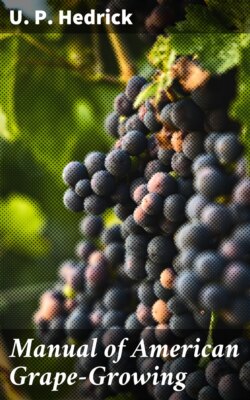Читать книгу Manual of American Grape-Growing - U. P. Hedrick - Страница 103
На сайте Литреса книга снята с продажи.
Cover-crops.
ОглавлениеIn an experiment being conducted by the New York Agricultural Experiment Station, grapes do not give a very appreciable response to cover-crops in yield of fruit or growth of vine.[9] There seem to be no other experiments to confirm the results at the New York Station, and grape-growers nowhere have used cover-crops very generally for the betterment of their vineyards. There is doubt, therefore, as to whether grapes will respond profitably to the annual use of cover-crops in yield of fruit, which, of course, is the ultimate test of the value of cover-crops, but a test hard to apply unless the experiment runs a great number of years.
Leaving out the doubtful value of cover-crops in increasing the supply of plant-food and thereby producing an increase in yield, there are at least three ways in which cover-crops are valuable in the vineyard. Thus, it is patent to all who have tried cover-crops in the vineyard that the land is in much better tilth and more easily worked when some green crop is turned under in fall or spring; it is not unreasonable to assume, though it is impossible to secure reliable experimental data to confirm the belief, that cover-crops protect the roots of grapes from winter-killing; certainly it may be expected that a cover-crop sowed in midsummer will cause grapes to mature their wood earlier and more thoroughly so that the vines go into the winter in better condition. The only objection to be raised against cover-crops in the vineyard is that pickers, mostly women, object to the cover-crop when wet with rain or dew and usually choose to pick in vineyards having no such crop. This seemingly insignificant factor often gives the grape-grower who sows cover-crops much trouble in harvest time.
Several cover-crops may be planted in vineyards as clover, vetch, oats, barley, cow-horn turnip, rape, rye and buckwheat. Combinations of these usually make the seed too costly or the trouble of sowing too great. Yet some combinations of a leguminous and non-leguminous crop would seem to make the best green crop for the grape. Thus, a bushel of oats or barley plus ten pounds of clover or twenty pounds of winter vetch, a combination often used in orchards, should prove satisfactory in the vineyard. Or, doubling the amount of seed for each, these crops could be alternated, with a change in the rotation every four or six years, with cow-horn turnip or rape. Turnip and rape require at least three pounds of seed to the acre.
The cover-crop is sown in midsummer, about the first of August in northern latitudes, and should be plowed under in the fall or early spring. Under no circumstances should the green crop be permitted to stand in the vineyard late in the spring to rob the vines of food and moisture. The weather map must be watched at sowing time to make sure of a moist seed-bed. Plate III illustrates two vineyards with well-grown cover-crops.
